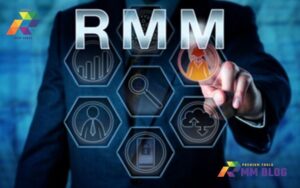RMM – In today’s fast-paced digital landscape, businesses are turning to Remote Monitoring and Management (RMM) software to streamline their IT operations. But what exactly is RMM software, and how does it work?
RMM software meaning refers to a specialized tool used by managed service providers (MSPs) to monitor and manage client systems remotely. This software plays a critical role in ensuring network stability, minimizing downtime, and enhancing overall productivity.
By automating routine IT tasks and providing real-time insights, RMM software allows businesses to maintain optimal performance without the need for constant on-site monitoring. In this article, we will explore the key benefits of using RMM software, recommend some of the top options available, and provide tips on how to choose the right solution for your needs.
Table of Contents:
Advantages of Using RMM Software
Implementing RMM software in your business offers a wide array of advantages that can significantly improve IT operations. By understanding the RMM software meaning, you can see how it benefits your company’s efficiency and security.
1. Proactive Monitoring
Proactive monitoring is one of the most significant advantages of using RMM software. This feature allows businesses to detect issues before they become major problems, ensuring seamless operations. With real-time alerts, IT teams can address potential failures immediately, reducing downtime and increasing overall productivity.
2. Automated Maintenance
Another key benefit of RMM software is its ability to automate routine IT maintenance. This includes tasks such as patch updates, system backups, and security scans. By automating these repetitive processes, businesses can reduce manual errors, save time, and allow their IT staff to focus on strategic initiatives.
Top RMM Tools for MSPs: Enhance Efficiency & Security

3. Improved Security
Security is a critical concern for all businesses, and RMM software plays a crucial role in improving it. With features such as real-time threat detection, automated patching, and vulnerability scanning, RMM solutions help businesses protect sensitive data and reduce the risk of cyberattacks.
4. Cost Efficiency
RMM software offers cost-saving benefits by reducing the need for frequent on-site IT support. By remotely managing IT infrastructure, companies can save on operational costs, minimize downtime, and allocate resources more efficiently, making the software a cost-effective solution for any size business.
5. Enhanced Scalability
For growing businesses, scalability is essential. RMM software provides the flexibility to scale IT operations as the business grows. Whether managing a small network or a large enterprise, RMM solutions can adapt to the changing needs of the company, ensuring that IT systems remain reliable as the business expands.
Top RMM Software Recommendations
Choosing the right RMM software is crucial to optimizing your IT management. Based on the RMM software meaning, it’s important to select a solution that fits your business needs, offering robust features and reliable performance. Below are some of the best RMM software options available in the market.
1. ConnectWise Automate
ConnectWise Automate is one of the most comprehensive RMM software solutions available. Known for its powerful automation capabilities, it allows businesses to streamline IT management processes.
With features such as system monitoring, remote access, and ticketing, ConnectWise Automate helps identify and resolve issues quickly. Additionally, it integrates seamlessly with other tools, making it an ideal solution for Managed Service Providers (MSPs) looking to enhance efficiency and reduce manual tasks.
Top Benefits of RMM Service for Your Business IT Needs

2. NinjaRMM
NinjaRMM is designed to be user-friendly while offering a strong set of features that improve IT operations. Its key capabilities include patch management, remote monitoring, and endpoint security.
The intuitive interface makes it easy for small and medium-sized businesses to get started without a steep learning curve. NinjaRMM also provides real-time alerts and customizable reporting, allowing IT teams to stay on top of system health and ensure optimal performance.
3. Atera
Atera offers an all-in-one platform that combines RMM with Professional Services Automation (PSA), making it a versatile option for MSPs. Atera provides unlimited device monitoring at a flat rate, which is a unique pricing model compared to other RMM tools.
It also includes features such as remote access, patch management, and real-time monitoring, which help improve IT service delivery. With its simple setup and cost-effective pricing, Atera is ideal for growing businesses looking for scalable IT management solutions.
4. SolarWinds RMM
SolarWinds RMM is another leading solution that offers powerful IT management capabilities. With features like automated patching, antivirus monitoring, and cloud-based backups, it provides comprehensive coverage for network security and system performance.
SolarWinds RMM is particularly suited for MSPs that need to manage multiple clients efficiently, as it offers multi-tenant dashboards and detailed reporting tools.
5. Kaseya VSA
Kaseya VSA is a robust RMM software that focuses on providing advanced IT management features, including endpoint monitoring, automated patching, and real-time system alerts.
It also offers strong integrations with various security tools, making it a popular choice for businesses prioritizing data protection. Kaseya VSA is highly scalable and can be customized to fit the needs of both small businesses and large enterprises.
Maximize Efficiency with RMM ConnectWise for Your Business

These recommendations highlight some of the best options for businesses seeking to optimize their IT operations through RMM software. Whether you’re a small business or a Managed Service Provider (MSP), selecting the right RMM tool can greatly improve efficiency, security, and cost management.
Tips for Choosing the Right RMM Software
Selecting the appropriate RMM software is vital for enhancing your IT management capabilities. Understanding the **RMM software meaning** helps you appreciate the importance of making an informed decision. Here are some detailed tips to guide you in choosing the right RMM solution for your business needs.
1. Understand Your Business Needs
Before diving into the selection process, take the time to assess your specific business requirements. Identify the challenges you face in your current IT management and what features would best address these issues.
For example, if your team struggles with frequent system downtime, prioritize software that offers robust monitoring and alerting capabilities. Clearly outlining your needs will help you find an RMM solution tailored to your operational goals.
2. Look for Scalability
As your business evolves, so will your IT needs. Choose RMM software that can grow with your organization, accommodating an increasing number of devices and users without sacrificing performance.
A scalable solution allows you to add new features or capabilities as needed, ensuring that your IT management remains efficient and effective over time. Check if the software can handle multi-site management if your organization expands geographically.
3. Evaluate Support and Training
Quality customer support and training resources are crucial when adopting new software. Ensure the RMM provider offers comprehensive onboarding programs, tutorials, and responsive customer service.
This support will be invaluable in helping your team fully utilize the software’s features and troubleshoot any issues that may arise. Look for user reviews and testimonials regarding the quality of support to gauge how reliable the provider is.
4. Consider Integration Capabilities
Your RMM software should seamlessly integrate with your existing tools and systems. Look for solutions that can connect with your current ticketing systems, security software, and other IT management tools.
This integration is essential for streamlining workflows and enhancing overall efficiency. It also helps avoid data silos, allowing your team to access and share information easily.
5. Review Pricing Models
RMM software comes with various pricing structures, from subscription-based models to one-time licensing fees. Evaluate your budget and consider the long-term costs associated with each option.
Some providers offer tiered pricing based on the number of devices or users, while others may provide unlimited access for a flat rate. Make sure to factor in any additional costs for features you may need in the future, such as advanced security options or premium support services.
6. Test the Software with a Trial
Many RMM software vendors offer free trials or demo versions of their products. Take advantage of these opportunities to test the software in your environment before making a commitment.
During the trial, assess the user interface, feature set, and overall performance to determine if it meets your expectations. Engage your IT team in this testing process to gather their feedback and ensure the software aligns with their workflow.
7. Seek Recommendations and Reviews
Consult industry peers or online communities for recommendations and reviews of RMM software. Real-world experiences can provide valuable insights into the strengths and weaknesses of various solutions.
Look for software that is widely used in your industry, as it may offer specific features tailored to your needs. Additionally, exploring professional reviews and comparison articles can help you make a more informed choice.
By following these tips, you can make a well-rounded decision when selecting RMM software that not only meets your current needs but also positions your business for future growth and success.
FAQs
Conclusion
RMM software is a powerful tool that simplifies IT management, enhances security, and improves operational efficiency for businesses of all sizes. By understanding the RMM software meaning, you can make informed decisions about integrating it into your IT infrastructure.
Whether you’re a small business looking to automate routine tasks or an MSP managing multiple clients, choosing the right RMM solution is crucial to maintaining system stability and growth.
By following the tips and recommendations outlined in this article, you’ll be well-equipped to find the best RMM software to suit your business needs.

